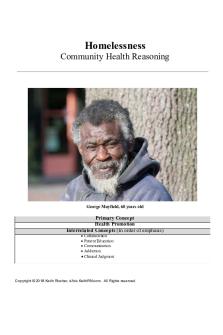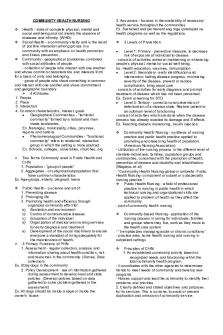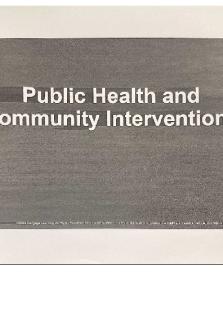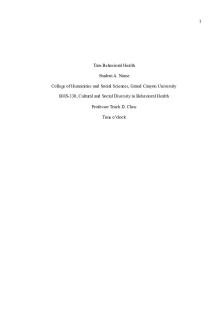Community Health Diagnosis PDF

| Title | Community Health Diagnosis |
|---|---|
| Course | Bs Nursing |
| Institution | Tarlac State University |
| Pages | 136 |
| File Size | 5.3 MB |
| File Type | |
| Total Downloads | 109 |
| Total Views | 462 |
Summary
Republic of the Philippines TARLAC STATE UNIVERSITY COLLEGE OF SCIENCE DEPARTMENT OF NURSING Villa Lucinda Campus, Brgy. Ungot, Tarlac City Philippines 2300 Tel. No.: (045) 493-1865 Fax: (045) 982-0110 website: www/tsu.eduA COMMUNITY DIAGNOSIS Presented to the Faculty of the College of Science Depar...
Description
Republic of the Philippines TARLAC STATE UNIVERSITY COLLEGE OF SCIENCE DEPARTMENT OF NURSING Villa Lucinda Campus, Brgy. Ungot, Tarlac City Philippines 2300 Tel. No.: (045) 493-1865 Fax: (045) 982-0110 website: www/tsu.edu.ph
A COMMUNITY DIAGNOSIS Presented to the Faculty of the College of Science Department of Nursing, Tarlac State University Lucinda Campus, Brgy. Ungot, Tarlac City, Philippines In Partial Fulfillment of the Requirements of the Subject NURSING CARE MANAGEMENT 113
A COMMUNITY DIAGNOSIS BARANGAY MARIKIT, TARLAC CITY, TARLAC
Presented by: BSN II-C, Group C3 and C4 Date Submitted: May 21, 2020
Presented to: LEONY H. OFRECIO, RN, MAN Clinical Instructor
TABLE OF CONTENT ACKNOWLEDGEMENT ---------------------------------------------------------------------------------5 I.
BACKGROUND OF THE COMMUNITY Introduction----------------------------------------------------------------------------------6 Objectives of the Community Diagnosis------------------------------------------------8 Methodology used in the community diagnosis----------------------------------------9 Spot Map of Barangay Marikit, Tarlac City, Tarlac----------------------------------11 Scope and delimitation of the Community Diagnosis-------------------------------- 12 Reason for choosing the Community---------------------------------------------------12
II.
COMMUNITY HEALTH ASSESSMENT Presentation of data---------------------------------------------------------------------13 A. Demographic Variables Total Population---------------------------------------------------------------------------13 Total Household---------------------------------------------------------------------------13 Age -----------------------------------------------------------------------------------------13 Sex Distribution---------------------------------------------------------------------------15 Civil Status Distribution-----------------------------------------------------------------16 Number of registered live births--------------------------------------------------------17 Years of Stay------------------------------------------------------------------------------19 Religious Affiliation----------------------------------------------------------------------20 Cultural Background----------------------------------------------------------------------22 Highest
Educational
Attainment-----------------------------------------------------------------24 Type of school-----------------------------------------------------------------------------26 Can read, can write------------------------------------------------------------------------29 Type of family structure------------------------------------------------------------------32 B. Socio – Economic Variables Mode of Communication-----------------------------------------------------------------33 Type of transportation--------------------------------------------------------------------35
2
Monthly income---------------------------------------------------------------------------36 Source of income--------------------------------------------------------------------------38 Health care resources---------------------------------------------------------------------40 C. Political Leadership Aspect Most recognized leaders-----------------------------------------------------------------42 D. Environmental Variables Land ownership---------------------------------------------------------------------------44 Type of material used for house--------------------------------------------------------45 Electricity----------------------------------------------------------------------------------47 Excreta disposal--------------------------------------------------------------------------48 drainage system---------------------------------------------------------------------------51 Waste disposal----------------------------------------------------------------------------53 Sources for drinking water--------------------------------------------------------------55 Domestic animals------------------------------------------------------------------------56 Presence of breeding sites of vectors and rodents-----------------------------------58 E. Health Variables Awareness in community health programs-------------------------------------------61 Current Common illness and diseases------------------------------------------------64 Availability of health system-----------------------------------------------------------67 Immunization status---------------------------------------------------------------------69 III.
COMMUNITY HEALTH CARE PLANNING Top 10 Community needs identification-----------------------------------------------71 Top 5 identified community problems-------------------------------------------------90
IV.
IMPLEMENTATION Alternative course of action for identified health needs----------------------------------91
V.
EVALUATION------------------------------------------------------------------------------103
3
VI.
SUMMARY, CONCLUSION AND RECOMMENDATION----------------------103
VII.
BIBLIOGRAPHY--------------------------------------------------------------------------109
VIII.
APPENDICES Appendix A: Organizational Chart------------------------------------------------------------110
4
ACKNOWLEDGEMENT We, the student nurses, would like to express our heartfelt gratitude and sincere gratitude to the following individuals for their unwavering support, guidance, assistance, and motivation in ensuring the success of this study. This page is for them all. To our cherished University President, Dr. Myrna Q. Mallari, for raising academic excellence in Tarlac State University. To the faculty members of the College of Science, Department of Nursing of Tarlac State University, our College of science Dean, Prof. Mary Jane N. Rigor, RN, MSN for the help and assistance on the community activities and also for elevating the student’s competencies. To Mrs. Leony Ofrecio, RN, MAN, Mr. Harold Panlilio, RN, MAN, and Mrs. Adora Obregon RN, MAN, our beloved Clinical instructor, for being generous in sharing their experience and for sacrificing their time and effort to assist us in conducting this case study. You are with us, rain or shine, Ma'am and Sir. Thank you so much! To our classmates, BSN II-C, for their unwavering encouragement even though things seemed difficult to complete during the case study's completion. To our supportive parents, for the moral and financial support especially for understanding their situation during the accomplishment of the study. And, of course, to our Omniscient God for allowing us to see and touch the lives of community members; for providing us with the strength and courage to face the challenges, struggles, and sacrifices that this study entailed; and for providing us with knowledge, provision, and unending assistance.
5
I.
BACKGROUND OF THE COMMUNITY INTRODUCTION The World Health Organization (WHO) defines health as a “state of complete
physical, mental, and social well-being, and not merely the absence of disease or infirmity.” Dr. C.E. Winslow defines public health as the “science and art of preventing disease, prolonging life, promoting health and efficiency through organized community effort for the sanitation of environment, control of communicable diseases, the education of individuals in personal hygiene, the organization of medical and nursing services for the early diagnosis and preventive treatment of disease, and the development of the social machinery to ensure everyone a standards of living adequate for the maintenance of health, so organizing these benefits as to enable every citizen to realize his birth right of health and longevity.”
Public health is defined by WHO as the “art of applying science in the context of politics so as to reduce inequalities in health while ensuring the best health for the greatest number.” Public Health Nursing was defined by the World Health Organization Expert Committee of nursing as a “special field of nursing that combines the skills of nursing, public health and some phases of social assistance and functions as part of the total public health programs for the promotion of health, improvement of the condition in the social and physical environment, rehabilitation of illness and disability. Community Health Nursing according to Ruth B. Freeman is a service rendered by a professional nurse with communities, groups, families, individuals at home, in health centers, in clinics, in schools, in places of work for the promotion of health, prevention of illness, care of the sick at home and rehabilitation. It is a nursing practice in a wide variety of community services and consumer advocate areas, and in variety of roles, at times including independent practice. community nursing is certainly not confined to public health nursing agencies. (Jacobson)
The public health nurses in the Philippines are utilizing the nursing skills in the application of public health functions and social assistance within the context of public health programs designed to promote health and prevent diseases. According to WHO, these are the factors that make people healthy or not, also known as determinants:
•
Income and Social status
•
Education
•
Physical Environment
•
Employment
•
Social support networks
•
Culture
•
Genetics
•
Personal behavior
•
Health services
•
Gender
Community health purposes and goals are realized through the application of a series of steps that lead to desired results. The nursing process is central to all nursing actions- it is the very essence of nursing, applicable in any setting, in any frame of reference, and within any philosophy. Its uniqueness will depend on the best application of nursing and public health skills to family and community problems. (Public Health Nursing in the Philippines, National League of Philippine Government Nurses, Inc.)
Barangay Marikit continuously thrives to be a progressive community with a total of 20 households and a population of 106 individuals. The total land area of this barangay is 100.10 hectares. Even with a small population, Brgy. Marikit is diverse and rich in culture for the languages spoken within this community are Ilocano, Kapampangan, and Tagalog. This Barangay is composed of 3 Puroks; Purok Pagasa, Purok Masigla, and Purok Masipag. Problems within the community was observed such as environmental
sanitation, improper drainage system, improper garbage disposal, increased number of unvaccinated stray Dogs and more. This Community Diagnosis will show all the data, and this can be a big help to the officials to improve the community.
OBJECTIVES
General:
·
At the end of the rotation, the group will be able to increase the capability of the community to deal and analyze their health status in order to strengthen community resources and will be able to provide proper nursing interventions to develop the community awareness and participation regarding different community programs which will enable the people in the community in taking appropriate measures concerning community health status independently.
Specific:
1. To gather fact-based data during surveys and interviews in the community. 2. To recognize and examine the health condition of the community. 3. To prioritize health problems of the community according to the needs of the community to be able to provide proper nursing diagnosis. 4. To arrange an efficient nursing intervention to the identified problems in the community. 5. To strengthen the level of engagement of the people in the community regarding planning and implementation of good health practices to improve the community’s health status. 6. To take part in implementing and encouraging the people in the community with the prepared interventions and continue to maintain the application of the solutions associated with the growth and improvement of the community’s health status.
7. To evaluate the usefulness of the nursing interventions provided changes, and improvement of the health status of the community. METHODOLOGY This section covers the research method, the form of community diagnosis, the subjects and respondents, the research instrument, the data collection procedure, and the data processing methodology used in the analysis. Quantitative Descriptive method was utilized in this study. This method emphasizes objective measurements and the statistical, mathematical, or numerical analysis of data collected through
questionnaires,
surveys,
or
by
manipulating
pre-existing
statistical
data
using computational techniques. (Babbie, E.R, (2010). Comprehensive community diagnosis and problem-oriented community diagnosis were the two forms of community diagnosis used. Questionnaires, formal interviews and observations, a physical examination, and a study of documents were all used. The numerical data was provided in the form of graphs and tables.
The group is divided into their assigned work and committee 1. Community Survey Committee
-
All group members
2. Record Review Committee
-
All group members
3. Spot Map Committee
Tiffany Blanche Cristobal
-
·
Community Survey Committee These groups are in charge of conducting the community survey. They are also responsible for creating Tally Sheets for the data that will be used in the study after surveying the families in the group.
·
Records Review Committee These committees will gather vital information such as the barangay's history and current status in the community's health center, as well as information from City Hall.
·
Spot Map Committee These groups are in charge of sketching the community's maps and identifying the landmarks needed for documentation. They are in charge of appointing and tracking our group's participants as they roam and survey the neighborhood.
SPOT MAP OF BARANGAY MARIKIT TARLAC CITY, TARLAC
PUROK PAG-ASA
PUROK MASIGLA
PUROK MASIPAG
Scope and Delimitation We, the BSN2-C Group C3 and C4 of Tarlac State University, College of Science Department of Nursing conducted a Community Diagnosis at Barangay Marikit, Tarlac City, Tarlac. May of 2021 was given date to us for the collection of data. The total number of households/families being surveyed is 20 which is the 100% of the total households/families at Barangay Marikit, Tarlac City, Tarlac.
Reason for choosing Barangay Marikit The group chose Barangay Marikit because it was found out that the community possess various problems that may affect their health and activities of daily living. Moreover, they need to be enlightened with regards to health promotion, health maintenance and environmental sanitation. They need to be educated to create awareness in regard to their health because the primary goal of community health nursing is to help a community protect and preserve the health of its members and promote selfcare among individuals and families. In this way, the group will be able to reduce or eradicate the health threats in the community.
II.
COMMUNITY HEALTH ASSESSMENT
Presentation of Data Total Population: 106 Total Households: 20 a. Demographic Variables A.1. AGE DISTRIBUTION Table 1. Shows the graph of age distribution in the community of Brgy. Marikit, Tarlac City, Tarlac by surveying as of May 2021.
Age
Frequency
Percentage
0-5 months
1
0.94%
6-12 months
1
0.94%
1-3 years
4
3.77%
4-6 years
8
7.55%
7-12 years
18
16.98%
13-18 years
17
16.04%
19-24 years
12
11.32%
25-35 years
10
9.43%
36 above
35
33.02%
Total
106
100 %
Interpretation The graph shows that both age range of 0-5 months and 6-12 months have 0.94% of the given population, 1-3 years old has a percentage of 3.77% and 7.55% for 4-6 years of age, while the 7-12 years old has a percentage of 16.98%, the 13-18 years old was 16.04% and 11.32% for 19-24 years old, the remaining 9.43% belongs to the 25-35 years of age and the highest percentage of 33.02% is 36 years old and above. Norms In the age composition, it consists of median age and dependency ratio. The median age asserts the middle of the age wherein it signifies the above and below of the given population and get its middle frequency. The dependency ratio compares the number of economically dependent with the economically productive group in the population. It represents the number of economically dependent for every 100 economically productive. According to the recent studies, they convey that the human life span is now declining due to lifestyle
changes and poor health services accompanied by knowledge deficit on proper health maintenance and disease prevention. (Potts, 2011. “Pediatric Nursing, Caring for Children and Their Families”)
Analysis From the information shown in the pie chart above, it was evident that 36 and above age range have the highest percentage of the population while the age range 0-5 and 6-12 months has the lowest percentage. Therefore, we can conclude that there are more older adults in the community compare to younger adults and children. . A.2. SEX DISTRIBUTION Table 2. Shows the sex distribution in the community of Brgy. Marikit, Tarlac City, Tarlac by surveying as of May 2021.
Category Female Male Total
Interpretation In the total of 106 population that have been surveyed, 57 of it was female with the percentage of 53.77% and 49 were male with the percentage of 46.23%. The sex ratio is equals to 100%.
Norms According to the World Data atlas, the percentage of male every 100 female is 67.36%. The sex distribution requires sex ratio where in it compares the number of males to the number of females in the certain population. It represents the number of males in every 100 females and vice versa. In the society, males define as ambitious and decisive while the female are sometimes seen as dependent, nurturing, and incapable of holding power. Gender roles or sex roles refer to a set of expectations prescribing how males and females should act, think and feel. (Maglaya, 2004. “Nursing Practice in the Community”) Analysis With the information presented in the pie chart above, we can obviously see that the females have a slightly higher percentage than the males. Therefore, this clearly shows that the number of female is slightly greater than the number of male in the community. However, this distribution is almost equal, hence it can hardly impact the overall situation in the community.
A.3. Civil Status Distribution Table 3. Shows the Civil Status in the community of Barangay Marikit Tarlac City, Tarlac surveying as of May 2021
CIVIL STATUS
Frequency 26
Percentage 24.53%
Married
41
38.68%
Common Law
6
5.66%
Child
33
31.13%
TOTAL: Interpreta...
Similar Free PDFs

Community Health Diagnosis
- 136 Pages

Community Diagnosis AND Mobilization
- 26 Pages

Community health final
- 14 Pages

Community Health Nursing RLE
- 15 Pages

ATI Community Health Focus
- 24 Pages

ATI Community Health Study
- 22 Pages

Community Health Nursing Kaplan
- 41 Pages
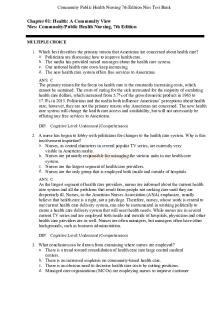
Community Health Test Bank
- 10 Pages

Nurs 2014 community health
- 41 Pages

COMMUNITY HEALTH NURSING NOTES
- 2 Pages
Popular Institutions
- Tinajero National High School - Annex
- Politeknik Caltex Riau
- Yokohama City University
- SGT University
- University of Al-Qadisiyah
- Divine Word College of Vigan
- Techniek College Rotterdam
- Universidade de Santiago
- Universiti Teknologi MARA Cawangan Johor Kampus Pasir Gudang
- Poltekkes Kemenkes Yogyakarta
- Baguio City National High School
- Colegio san marcos
- preparatoria uno
- Centro de Bachillerato Tecnológico Industrial y de Servicios No. 107
- Dalian Maritime University
- Quang Trung Secondary School
- Colegio Tecnológico en Informática
- Corporación Regional de Educación Superior
- Grupo CEDVA
- Dar Al Uloom University
- Centro de Estudios Preuniversitarios de la Universidad Nacional de Ingeniería
- 上智大学
- Aakash International School, Nuna Majara
- San Felipe Neri Catholic School
- Kang Chiao International School - New Taipei City
- Misamis Occidental National High School
- Institución Educativa Escuela Normal Juan Ladrilleros
- Kolehiyo ng Pantukan
- Batanes State College
- Instituto Continental
- Sekolah Menengah Kejuruan Kesehatan Kaltara (Tarakan)
- Colegio de La Inmaculada Concepcion - Cebu

